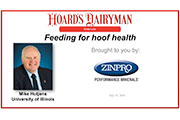 Hoof issues are a concern for many dairy producers. They can limit feed intake, sacrifice milk production, and impair cow comfort. Along with a comprehensive foot care program nutrition plays a key role in ensuring that cows are healthy from head to hoof.
Hoof issues are a concern for many dairy producers. They can limit feed intake, sacrifice milk production, and impair cow comfort. Along with a comprehensive foot care program nutrition plays a key role in ensuring that cows are healthy from head to hoof.Recognizing a problem is the first step in minimizing or eliminating it. If a cow is not severely lame, we may not notice her mobility issues. If an issue is not obvious, it may not be perceived as a problem needing immediate attention, but early on is the best time to get ahead of it.
Lame cows will have affected locomotion and posture, altered foot shape, higher culling rates, and be harder to get bred back. Lame cows are more likely to develop cystic ovaries, take longer to reach first service, and have more services per conception as compared to normal cows. These incremental components all culminate into a drop in milk production. Research indicates the cost of a lameness occurrence is just under $500 when considering all the above factors.
Cows need to be able to move freely to allow continual blood flow to the hooves, which provides oxygen to the area. Laminitis reduces circulation and impairs mobility. Signs of laminitis include erratic shifts in dry matter intake, loose fecal droppings, and consumption of bedding and dirt.
The fiber in the ration will also contribute to foot health. A shaker box can help measure the particle sizes of your ration. Along with visible inspection of feedbunks, you can determine whether feed sorting is an issue. When sorting occurs, the balanced ration you created is not being consumed as certain nutrients may be left in the feedbunk.
The webinar goes into further detail on why sulfur, copper, zinc, manganese, calcium, phosphorus, and iodine all play a role on hoof health. Their benefits include maintaining elastic tissue, hoof hardness, immunity, bone density, and skeletal soundness.
Biotin, a B vitamin, is also an important component, particularly in dealing with sole ulcers, digital dermatitis, vertical fissures, and white line disease. The benefit to cost ratio is a favorable 4:1. Other feed additives such as buffers, monensin, and yeast can all benefit hoof health.
The webinar was sponsored by Zinpro (www.zinpro.com) and can be viewed here. All past webinars can be seen at www.hoards.com/webinars.

The author is the online media manager and is responsible for the website, webinars and social media. A graduate of Modesto Junior College and Fresno State, she was raised on a California dairy and frequently blogs on youth programs and consumer issues.








